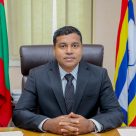
Hassan Mughnee
Managing Director of STELCO
Energy / Maldives
“I want to see 50% of our generation coming from solar within the next 5 years”
STELCO has taken the fight for renewable energy production head-on. In 2019, the company launched a new solar center to provide photovoltaic solutions across the country’s many resort islands, while deploying solar generation in its own network, to achieve very ambitious short-term goals.
What is the state of STELCO’s renewable energy network?
The percentage of renewable power in the national grid is still small but it is growing rapidly. Currently STELCO operates two solar power generation stations in two separate islands. We have also initiated a pilot floating solar power project. Together, these projects have a 3MW solar generation capacity. We are also working on the expansion of the two “100% Renewable Energy Islands” projects in V. Rakeedhoo and Adh. Dhidhdhoo.
The ministry of environment is also promoting the development of a new 5MW solar power plant in the Greater Malé Region, which has already passed the bidding stage.
Within the Renewable energy spectrum, solar is absolutely dominant in the Maldives. There have been some studies regarding harnessing wave and wind energy but so far only solar has been tried.
Total generation capacity 129 MW
Renewable Energy Capacity 3MW
Greater Male Region consumes 80MW of power
STELCO solar power generation goal: 50% in 5 years
Government’s solar power generation goal: 8% by end of 2019
What are the main challenges in the country’s move towards renewable energy?
The Maldives has very high solar exposure, which makes this form of power generation efficient and economically sustainable. Besides, taking into account the country’s serious concerns regarding climate change, the move to solar is fundamental. Today, the country depends mostly on diesel powered generators, and while the light diesel we use is less polluting than heavy oils used elsewhere, we still need better solutions.
The challenge lies in our geography. In contrast to other countries, the Maldives doesn’t have a central grid, but a myriad of micro-grids. One major power generating center distributing power to a large population is not a model that works here. Further, solar has an intermittency problem, so we are opting for a hybrid system that mixes diesel-powered generation at night and solar during the day. We could potentially adapt our energy matrix into 30 percent solar generation on this model. However, beyond that we would need to rely on solar power batteries, to be able to accumulate energy during the day to distribute at night. That is where costs spike and economic viability becomes a problem. There is also the matter of space. Even if the greatest concentration of power generation is the Greater Male Region, where we are working on integrating the power grids of Hulhumalé, Malé and other islands through the connectivity bridges that are being developed, there is simply not enough space for major solar parks.
In this structure, I believe the government’s goal of 8 percent of renewables by the end of 2019 is manageable. For STELCO’s network, I want 50 percent of our power coming from solar within the next five years.
How is STELCO promoting the use of renewables in the many resort islands?
In the case of Resort islands, it depends on the operators themselves, but the solutions are now present. We have created a Solar Center within STELCO this year that provides solar generation and installation upon client request. Not just for resorts, but for any client in the country. We provide solar panel installation and connectivity to domestic households and businesses. If an island’s local council wishes to completely shift into solar, they can hire STELCO to provide all the equipment and installation to make it happen, as well as operate the plants. We haven’t completely opened it to the public yet, because first we want to focus these services on the opportunities present in the 35 islands where we operate as power supplier. However, there is much opportunity for these services to expand when you consider that many remote islands depend on expensive barge diesel imports to produce electricity for a relatively small amount of people.
